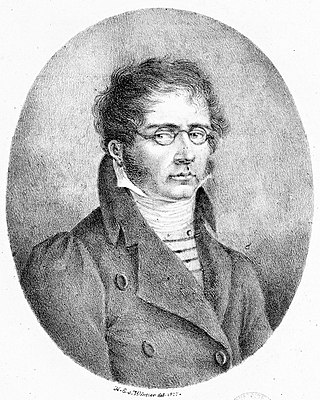Related Research Articles

A string quintet is a musical composition for five string players. As an extension to the string quartet, a string quintet includes a fifth string instrument, usually a second viola or a second cello, or occasionally a double bass.

Franz Ignaz Danzi was a German cellist, composer and conductor, the son of the Italian cellist Innocenz Danzi (1730–1798) and brother of the noted singer Franzeska Danzi.

A string orchestra is an orchestra consisting solely of a string section made up of the bowed strings used in Western Classical music. The instruments of such an orchestra are most often the following: the violin, which is divided into first and second violin players, the viola, the cello, and usually, but not always, the double bass.

In classical music, a string sextet is a composition written for six string instruments, or a group of six musicians who perform such a composition. Most string sextets have been written for an ensemble consisting of two violins, two violas, and two cellos.
The Sinfonia Concertante for Violin, Viola and Orchestra in E♭ major, K. 364 (320d), was written by Wolfgang Amadeus Mozart.

A viola concerto is a concerto contrasting a viola with another body of musical instruments such as an orchestra or chamber music ensemble. Throughout music history, especially during the Baroque, Classical, and Romantic eras, viola was viewed mostly as an ensemble instrument. Though there were a few notable concertos written for the instrument in this time period, these instances were quite rare and the instrument continued to be ignored. However, during the 20th century, the instrument was revitalized thanks to the work of a number of violists and composers, which led to the commission and composition of many more viola concertos, expanding the repertoire significantly.
D major is a major scale based on D, consisting of the pitches D, E, F♯, G, A, B, and C♯. Its key signature has two sharps.
B-flat major is a major scale based on B♭, with pitches B♭, C, D, E♭, F, G, and A. Its key signature has two flats. Its relative minor is G minor and its parallel minor is B-flat minor.
E-flat major is a major scale based on E♭, consisting of the pitches E♭, F, G, A♭, B♭, C, and D. Its key signature has three flats. Its relative minor is C minor, and its parallel minor is E♭ minor,.

Bernhard Molique was a German violinist and composer.

Philip Cipriani Hambly Potter was an English musician. He was a composer, pianist, conductor and teacher. After an early career as a performer and composer, he was a teacher in the Royal Academy of Music in London and was its principal from 1832 to 1859.

Antonín Vranický, Germanized as Anton Wranitzky, and also seen as Wranizky, was a Czech violinist and composer of the 18th century. He was the half brother of Pavel Vranický.
This article lists notable compositions within the viola repertoire. The list includes works in which the viola is a featured instrument. The list is ordered by composer surname.

Marco Anzoletti was an Italian violinist and composer.
References
- ↑ "List of Compositions for String Sextet." International Music Score Library Project. Retrieved 20 June 2013.
- ↑ "Composer Luke Cissell Makes an Arresting Musical Statement with 'String Sextets Nos 1 & 2', PopMatters". 21 June 2019.
- ↑ See Edition Silvertrust, also Brown: Louis Spohr, a Critical Biography.
- ↑ Charleswuorinen.com